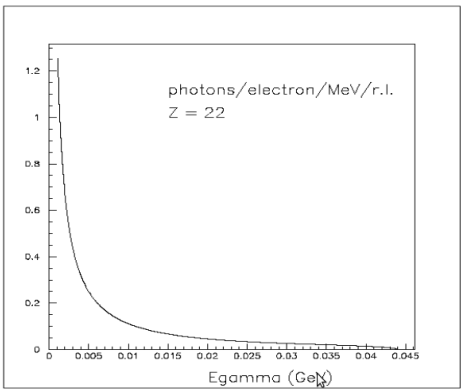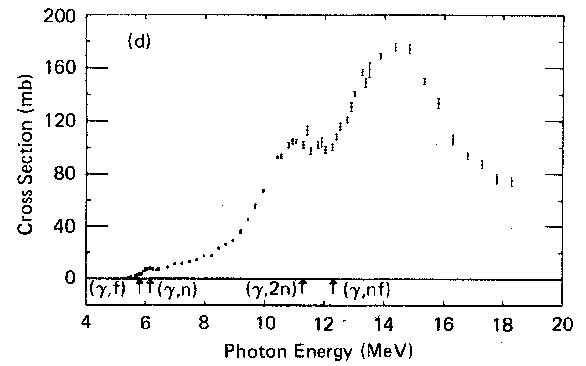Go Back
LINAC parameters used in calculations
1) pulse width 50 ns
2) pulse current 50 A
3) repetition rate 300 Hz
4) energy 44 MeV
Number of electrons/sec on radiator
[math] 50\ \frac{Coulomb}{sec} \times \frac{1\cdot e^-}{1.6\cdot 10^{-19}C} \times 50ps \times 300Hz = 0.47 \cdot 10^{13} \frac{e^-}{sec}[/math]
Number of photons/sec from radiator
bremsstrahlung

in (10,20) MeV region we have about
0.1 photons/electrons/MeV/r.l
radiation length
r.l.(Ti) = 3.59 cm
radiator thickness = 12.5 [math]\mu m[/math]
[math]12.5\mu m/3.59 cm = 3.48 \cdot 10^{-4} \ r.l.[/math]
steps together...
[math]0.1\ \frac{\gamma 's}{(e^- \cdot MeV \cdot r.l.)} \times 3.48 \cdot 10^{-4} r.l. \times 10\ MeV \times 0.47 \cdot 10^{13} \frac{e^-}{sec}=1.64 \cdot 10^{9} \frac{\gamma}{sec}[/math]
Collimation factor
Collimation factor is
4-6 % of total # of photons (Alex, GEANT calculation)
then, incident flux on target is
[math]1.64 \cdot 10^{9} \frac{\gamma}{sec} \cdot 5% = 8.2 \cdot 10^{7} \frac{\gamma}{sec}[/math]
Number of neutrons/sec (yields)
photonuclear cross section [math]\sigma (\gamma , F)[/math] for [math]^{238}U[/math]

in (10,20) MeV region the average cross section is:
130 mb
target thickness, [math]^{238}U[/math]
[math]\frac{19.1\ g/cm^3}{238.02\ g/mol} = 0.08\ \frac{mol}{cm^3} = 0.08\ \frac{mol}{cm^3} \times \frac{6.02\cdot 10^{23}\ atoms}{mol} = 0.48\cdot 10^{23}\ \frac{atoms}{cm^3}[/math]
Target thickness = 1 cm:
[math]0.48\cdot 10^{23}\ \frac{atoms}{cm^3} \times 1\ cm = 0.48\cdot 10^{23}\ \frac{atoms}{cm^2}[/math]
neutrons per fission
2.4 neutrons/fission
steps together...yeild
[math] Y = \frac{\gamma}{sec} \times t \times \sigma \times 2.4 = [/math]
[math] = 8.2 \cdot 10^{7} \frac{\gamma}{sec} \times 130\ mb \times 0.48\cdot 10^{23}\ \frac{atoms}{cm^2} \times 2.4 = 1.2 \cdot 10^{6}\ \frac{neutrons}{sec}[/math]
Worst Case Isotropic Neutrons
Let's say we have:
radius detector = 1 cm
1 meter away
fractional solid angle = [math]\frac{\pi * (1 cm)^{2}}{4 \pi (100cm)^{2}} = \frac{1}{4} \cdot 10^{-4}[/math] <= geometrical acceptance
finally we have
[math]1.2 \cdot 10^{6}\ \frac{neutrons}{sec} \times \frac{1}{4} \cdot 10^{-4} = 300\ \frac{neutrons}{sec} [/math]
Therefore, this experiment is really doable.
Go Back

